| |
|
|
|
|
This is a very unusual church for London, unusual for
England, for it was one of the very few churches to be
built during the Laudian years at the start of the 17th
Century. More than this, it can proudly claim that the
new church was consecrated by Archbishop Laud himself.
Even more, the vestments he wore and the ceremony he
oversaw on the occasion were both used in evidence
against him at his trial before he was summarily beheaded
by the Puritans. You don't get a much higher pedigree
than that.Under the
circumstances then, it is perhaps a little disappointing
that the church is rather traditional, rebuilt on the
exact foundations of its medieval predecessor, and
perhaps doesn't really reflect what we know of Laudian
worship at all. As Elizabeth and Wayland Young observed, it
answers no questions about its time, informing one only
that it was a time of change and indecision. The
same may be said of the almost exactly contemporary
church of St John in the city of Leeds in Yorkshire.
The dedication is an abbreviation
of St Katherine Creechurch or Christchurch, for this was
the site of the Augustinian Priory of Holy Trinity
Aldgate, the parish of which was known as Christchurch.
The people of the parish used the Priory church, which
the monks seem to have found something of a nuisance, so
in the 14th Century they gave the parish its own church,
which Simon Bradley suggests may have been the former
cemetery chapel. As the parish of Christchurch had been
made up of four earlier medieval parishes, the new church
took its dedication from one of them, St Katherine.
At the dissolution the parish was
offered the Priory church, but they turned it down,
probably because it was in a poor state of repair, or
perhaps they were merely proud of the new tower built
against their own church some thirty years earlier.
Instead, St Katherine Cree was rebuilt against the tower,
and consecrated in 1628. You step into an interior which
feels much larger than seems possible from outside. At
the time of the rebuilding the floor was raised up higher
than the old church. The ceilings are vaulted above the
deceptively powerful arcades, but it is the east window
that draws the eye, a rose window like a Catherine wheel,
one of the most memorable in London. Below it, the
semi-circular sanctuary is simple and elegant.
Much of the glass in the east
window is of the 1630s, as is that at the west end of the
north aisle, for this church survived the Great Fire.
Samuel Pepys described how it was used by the Corporation
as a meeting place in the days after it. At the east end
of the south aisle reclines Sir Nicholas Throkmorton who
died in 1570, above an altar as if he were a southern
European Catholic saint, and on the other side of the
church above the font provided at the time of the
rebuilding is another striking memorial to Bartholomew
and Ann Ensor, showing them as shrouded figures leaning
either side of the inscription. Bartholomew died in 1636,
so this must have been one of the first new memorials in
the rebuilt church. Most of the other windows are filled
with late 19th and early 20th Century glass of varying
quality, for this part of Leadenhall Street survived the
Blitz. And so, apart from Michael Farrar-Bell's 1960
memorial glass to the victims of the German bombing of RMS
Lancastria off the coast of France on 17th June 1940
with the loss of more than four thousand lives, St
Katherine Cree remains in all its pre-war singularity.
Simon Knott, March 2022
location: Leadenhall Street 3/033
status: working church in parish of St Olave
Hart Street
access: the church is open all day on Tuesdays.
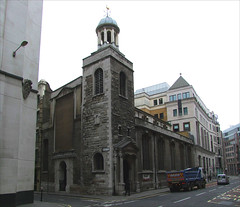 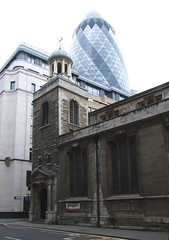 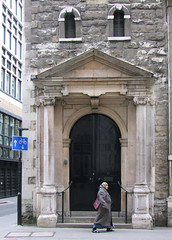 
 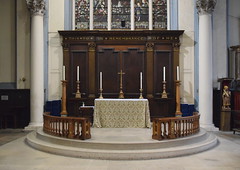 
   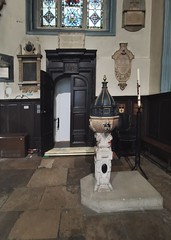
 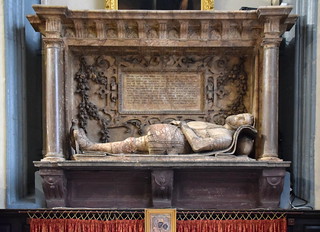 
  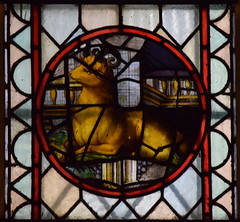
   
 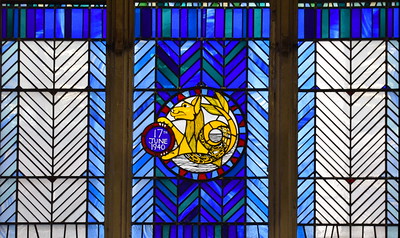
 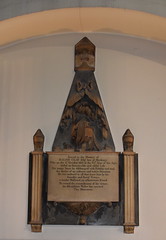 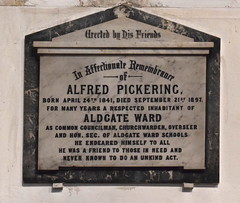
 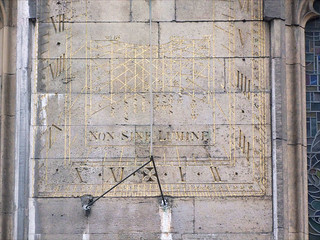
Commission
from Amazon.co.uk supports the running of this site
|
|
|
|
|
|



